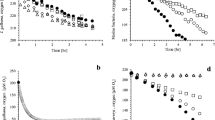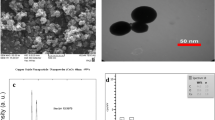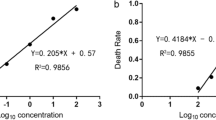Abstract
Toxic mechanisms of the red tide flagellate, Chattonella marina, collected in 1985 from Kagoshima Bay, Japan, were studied at the subcellular level. C. marina was found to reduce ferricytochrome c at a rate related to the concentration of plankton cells. Ca. 50% of the cytochrome c reduction was inhibited by the addition of 100 U superoxide dismutase ml-1. These results suggest that a part of the cytochrome c reduction was caused by a superoxide anion which was extracellulary released from C. marina. Moreover, a small amount of hydrogen peroxide was detected in the C. marina suspension using the fluorescence spectrophotometric assay method. The identity of the hydrogen peroxide was confirmed by its reaction with 500 U catalase ml-1. It is thus proposed that C. marina produces harmful active oxygen radicals and therefore exhibits a toxic effect on surrounding living organisms. In agreement with these results, C. marina strongly inhibited the proliferation of marine bacteria, Vibrio alginolyticus, in a plankton/bacteria co-culture system. The growth inhibition of bacteria caused by C. marina was related to the density and the metabolic potential of C. marina. Ruptured plankton showed no toxic effect on the bacteria. Furthermore, the toxic effect of C. marina on V. alginolyticus was completely suppressed by the addition of catalase and superoxide dismutase. In addition to these radical-scavenging enzymes, a chemical scavenger, sodium benzoate, also had a protective effect. These results suggest that oxygen radicals are important in the toxic action of C. marina.
Similar content being viewed by others
Literature cited
Asada, K., Kiso, K., Yoshikawa, K. (1974). Univalent reduction of molecular oxygen by spinach chloroplasts on illumination. J. biol. Chem. 249:2175–2181
Babior, B. M. (1978). Oxygen-dependent microbial killing by phagocytes. New Engl. J. Med. 298:721–725
Dean, R. T. (1987). Free radicals, membrane damage and cell-mediated cytolysis. Br. J. Cancer. 55:39–45
Fusetani, N., Ozawa, C., Hashimoto, Y. (1976). Fatty acids as ichthyotoxic constituents of a green alga Cheatomorpha minima. Bull. Jap. Soc. scient. Fish. 42:941
Halliwell, B., Gutteridge, J. M. C. (1984). Oxygen toxicity, oxygen radicals, transition metals and disease. Biochem. J. 219:1–14
Ishimatsu, A., Maruta, H., Tsuchiyama, T., Ozaki, M. (1990). Respiratory, ionoregulatory and cardiovascular responses of the yellowtail Seriola quinqueradiata to exposure to the red tide plankton Chattonella. Nippon Suisan Gakk. 56:189–199
Johnson, K. J., Fantone, J. C., Kaplan, P. A. (1981). In vivo damage of rat lungs by oxygen metabolites. J. clin. Invest. 67:983–993
Johnston, R. B., Godzik, C. A. Jr., Cohn, Z. A. (1978). Increased superoxide anion production by immunologically activated and chemically elicited macrophages. J. exp. Med. 148:115–127
Kakinuma, K., Minakami, S. (1978). Effects of fatty acids on superoxide radical generation in leukocytes. Biochim. biophys. Acta 538:50–59
Kamiya, H., Naka, K., Hashimoto, K. (1979). Ichthyotoxicity of a flagellate Vroglena volvox. Bull. Jap. Soc. scient. Fish. 45:129
Klebanoff, S. J. (1982). Oxygen-dependent cytotoxic mechanisms of phagocytes. In: Gallin, J. I., Fauci, A. S. (eds.) Advances in host defense mechanisms. Raven Press, New York, p. 111–162
McCord, J. M., Fridovich, I. (1969). Superoxide dismutase. J. biol. Chem. 244:6049–6055
Nakayama, T., Kaneko, M., Kodama, M., Nagata, C. (1985). Cigarette smoke induces DNA single-strand breaks in human cells. Nature, Lond. 314:462–464
Nathan, C. F., Root, R. K. (1977). Hydrogen peroxide release from mouse peritoneal macrophages. J. exp. Med. 146:1648–1662
Oda, T., Akaike, T., Hamamoto, T., Suzuki, F., Suzuki, F., Hirano, T., Maeda, H. (1989). Oxygen radicals in influenza-induced pathogenesis and treatment with pyran polymer conjugated SOD. Science, N.Y. 244:974–976
Onoue, Y., Nozawa, K. (1989). Separation of toxins from harmful red tides occurring along the coast of Kagoshima prefecture. In: Okaichi, T., Anderson, D. M., Nemoto, T. (eds.) Red tides: biology, environmental science, and toxicology. Elsevier, New York, p. 371–374
Oren, R., Farnham, A. E., Saito, K., Mifosky, E., Karnovsky, M. L. (1963). Metabolic patterns in three types of phagocytizing cells. J. Cell Biol. 17:487–501
Romeo, D., Zabucchi, G., Rossi, F. (1973). Reversible metabolic stimulation of polymorphonuclear leukocytes and macrophages by concanavalin A. Nature new Biol. 243:111–112
Shimada, M., Murakami, T. H., Imahayashi, T., Ozaki, H. S., Toyoshima, T., Okaichi, T. (1983). Effects of sea bloom, Chattonella antiqua, on gill primary lamellae of the young yellowtail, Seriola quinqueradiata. Acta histochem. cytochem. 16:232–244
Shimada, M., Shimono, R., Imahayashi, T., Ozaki, H. H., Murakami, T. H. (1986). Diazo-reaction positive substance observed in the cortex of Chattonella antiqua. Histol. Histopath. 1: 327–333
Shimada, M., Shimono, R., Murakami, T. H., Yoshimatsu, S., Ono, C. (1989). Red tide, Chattonella antiqua reduces cytochrome c fron horse heart. In: Okaichi, T., Anderson, D. M., Nemoto, T., (eds.) Red tides: biology, environmental science, and toxicology. Elsevier, New York, p. 443–446
Toyoshima, T., Ozaki, H. S., Shimada, M., Okaichi, T., Murakami, T. H. (1985). Ultrastructural alterations on chloride cells of the yellowtail Seriola quinqueradiata following exposure to the red tide species Chattonella antiqua. Mar. Biol. 88:101–108
Wallenstein, S., Zucher, C. L., Fleiss, J. L. (1980). Some statistical methods useful in circulation research. Circulation Res. 47:1–9
Author information
Authors and Affiliations
Additional information
Communicated by M. Anraku, Suva
Rights and permissions
About this article
Cite this article
Oda, T., Ishimatsu, A., Shimada, M. et al. Oxygen-radical-mediated toxic effects of the red tide flagellate Chattonella marina on Vibrio alginolyticus . Marine Biology 112, 505–509 (1992). https://doi.org/10.1007/BF00356297
Accepted:
Published:
Issue Date:
DOI: https://doi.org/10.1007/BF00356297




